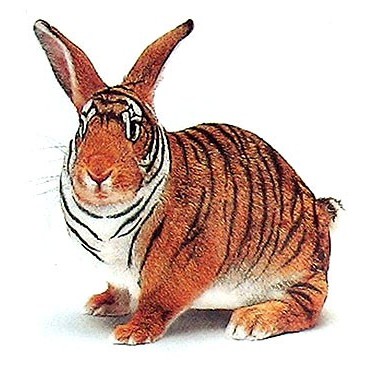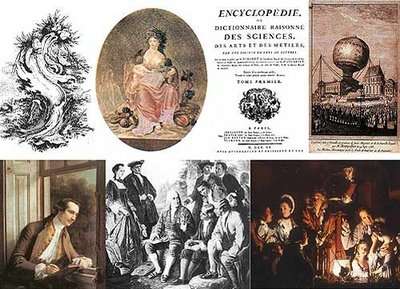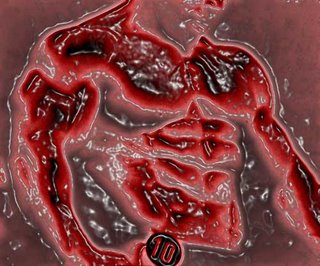The Tercentenary Lectures on Science and Art
by Mariano Akerman
Manila and Taytay, Philippines, 2007

27.12.06 - Embassy of Sweden, Manila, In the Spirit of Linnaeus: The Tercentenary Lectures on Science and Art, by Mariano Akerman, official brochure (PDF, published by SwedenAbroad)
Abstract. The year 2007 marks the tercentenary of the birth of the renowned Swedish biologist Carl Linnaeus (1707-1778). In Manila special events take place, to enhance his unique contribution in terms of systematic research. Indeed, Linnaeus was an enthusiastic man, a researcher who believed that curiosity was the only firm basis for scientific thought. Interested in mapping, studying, cataloguing and classifying the living species, Linnaeus wanted to understand the organizational principles underlying God's Creation. The Linnaean approach involves a systematic giving of names to the natural spacies or binary nomenclature, which is an attempt to clarify and simplify the scientific dialog, raising it to a universal level. Exploration, medicine, geology, anthropology, ecology and philosophy were among the many interests of Linnaeus. Considering the scientific and artistic developments of the Age of Reason, Linnaeus’ deductive approach and his systematic classification of life can be put in context. Searching for species to be discovered, collected, examined, described, named and classified, Linnaeus traveled across Scandinavia. He also played a key role in leading seventeen of his students to important scientific journeys all around the world. Conceived as an interdisciplinary forum, the Manila Series of Lectures on Linnaeus gather together the Sciences and the Arts, to focus on Linnaeus’ extraordinary contribution which was to lead us to a better understanding of the world that surrounds us.

Program Topics
1. A tribute to Linnaeus: the presence of flora and fauna in the visual arts throughout the ages
2. An exemplary Swede: Linnaeus’ place among his other famous compatriots
3. Linnaeus: his life and work
4. Linnaeus in the 18th Century context: scientific and artistic developments in the Age of Reason
5. Linnaeus as researcher: a multifaceted man and his methodology
6. The scientific journeys across Sweden and abroad
7. Scandinavian botanical and animal species
8. Realistic ways of recording a botanical specimen: herbarium, sketches, drawings and paintings, printed illustrations and photographs
9. Following God’s steps: Linnaeus names and orders Nature
10. Linnaeus’ two-word naming of the living species: Taxonomy, then an achievement and today a complication?
11. The process of classification: its peculiarities, difficulties and advantages, risks and importance
12. Classification and its types (accumulation, aggregation, group, collection, set, association, family, system; class, order, genera, species, variety)
13. Linnaeus’ rule-books: description, importance and projections
14. Attempting to map, name and classify the realm of fantasia
15. Surrealistic ways of recording reality: sculpture, painting, engraving and photography
16. Challenging the concept of category: the hybrid, its shape and symbolism

Mariano Akerman, Researcher and Lecturer. Mariano Akerman was born in Buenos Aires, Argentina, in 1963. He obtained a masteral degree in architecture and urbanism from the Universidad de Belgrano in Buenos Aires with a prized graduation project on the limits and space in modern architecture. […] Specializing in visual communication, Mr. Akerman is an experienced educator. He has worked at renowned institutions such as the Museo Nacional de Bellas Artes, Universidad de Belgrano and Universidad del Salvador in Buenos Aires […]. Today, Mr. Akerman resides in the Philippines, working as a professional lecturer at the National Museum of the Filipino People, De La Salle University, University of Santo Tomas, Ateneo de Manila University and the Embassy of Belgium in Manila. A painter himself, Mariano Akerman has exhibited solo or in group […]. He has been awarded with twelve major international prizes.
01.01.07 - LINNÉ 2007, Sweden "Linné ska göra filippinska studenter mer kreativa - Linnéjubiléet 2007 - Ambassador Annika Markovic of Sweden I Manila inleds Linnés jubiléumsår med en sexveckorsperiod föreläsningar på universitet och högskolor som man hoppas ska väcka nyfikenhet och ge inspiration till filippinska studenter. Linnéfirandet i Manila, Filippinerna, lanserades nyligen med en presskonferens/sponsorkväll i ambassadresidenset. Under en sex veckor lång period kommer universitet och högskolor i Metro Manila-området att engageras genom föreläsningar för studenterna om Linné och hans insatser.Vi vill inspirera filippinska studenter att följa i Linnés fotspår - att blir mer kreativa, innovativa och nyfikna. Föreläsningsserien arrangeras tillsammans med konstvetaren Mariano Akerman och det filippinska utbildningsdepartementet.Studenterna inbjuds också att delta i en uppsatstävling där den första vinsten är en resa till Sverige i samband med Linnés födelsedag den 23 maj. Avslutningsveckan gästas Manila-universiteten också av en svensk föreläsare och Linné-expert Dr. Lars Jonsson från Uppsala Universitet. En filippinsk konstnär Manuel Baldemor har också inspirerats av Linné vid besök i Uppsala att måla en serie akvareller om filippinsk fauna. Dessa kommer att ställas ut i residenset. Linnéfirandet i Manila är en del i ambassadens Sverige-arrangemang för att under hela 2007 uppmärksamma 60 år av diplomatiska relationer mellan Sverige och Filippinerna."
 linnaeus.se
linnaeus.se01.01.07 - Annika Markovic - EMBASSY OF SWEDEN, MANILA Events: Linnaeus 2007 2007 heralds the 60 Years of Diplomatic Relations between Philippines and Sweden and the 300th anniversary of the birth of Carl Linnaeus. To highlight these two momentous events, the Embassy of Sweden in Manila together with Mr. Mariano Akerman, Researcher and Lecturer, will organize a series of lectures with different universities and educational institutions entitled In the Spirit of Linnaeus, a [series of] Tercentenary Lectures on Science and Art from 11 January to 22 February 2007 that will enhance Linnaeus' consistent contribution in the field of systematic research. The primary goal of the lecture series is to promote interdisciplinary involvement and exchange of ideas in the Linnaeus Forum which we hope will increase the interest of young people in science and research (swedenabroad.com, retrieved 08.01.07). 11.01.07 - Rapeepat Jumnongjit, In the Spirit of Linnaeus, SCANDASIA, News for Scandinavia: Scandinavian News Portal for Southeast Asia Sweden and Philippines celebrate their 60 years of Diplomatic relations and the 300th anniversary of the birth of Carl Linnaeus. The Embassy of Sweden in Manila together with Mr. Mariano Akerman, Researcher and Lecturer will organize a series of lectures with different universities and educational institutions entitled “In the Spirit of Linnaeus”, a tercentenary Lectures on Science and Art from 11 January to 22 February 2007. 11.01.07 - Inger Ultvedt, 60 Years of Diplomatic Relations between Philippines and Sweden the 300th anniversary of the birth of Carl Linnaeus, SCANDASIA THAILAND, News for Scandinavia: Scandinavian News Portal for Southeast Asia 60 Years of Diplomatic Relations between Philippines and Sweden the 300th anniversary of the birth of Carl Linnaeus 2007 heralds the 60 Years of Diplomatic Relations between Philippines and Sweden and the 300th anniversary of the birth of Carl Linnaeus. To highlight these two momentous events, the Embassy of Sweden in Manila together with Mr. Mariano Akerman, Researcher and Lecturer, will organize a series of lectures with different universities and educational institutions entitled In the Spirit of Linnaeus, a Tercentenary Lectures on Science and Art from 11 January to 22 February 2007 that will enhance Linnaeus' consistent contribution in the field of systematic research.
 ateneo.edu
ateneo.edu21.01.07 - C. Jude Defensor, "In the Light of Linnaeus," WHAT'S ON & EXPAT, Philippines The year 2007 marks the 60th Anniversary of Diplomatic Relations between Philippines and Sweden and the 300th anniversary of the birth of Carl Linnaeus. To highlight these two momentous events, the Embassy of Sweden in Manila together with multi-awarded Researcher and Lecturer Mr. Mariano Akerman have organized a series of lectures with different universities and educational institutions entitled In the Spirit of Linnaeus, a Tercentenary Lectures on Science and Art, from 11 Jan. to 22 Feb. 2007. Conceived as an interdisciplinary forum, the Manila Series of Lectures on Linnaeus is meant to highlight Linnaeus significant contribution in the field of systematic research, and is hoped to lead to a better understanding of the world that surrounds us as a result of Linnaeus' curiosity and inventiveness. Venues for the lectures include the British School Manila, University of Sto. Tomas, European International School, International School Manila, Ateneo de Manila University, Lyceum of the Philippines University, Mahatma Gandhi International School, De La Salle University, and Feati University. Carl Linnaeus is Sweden's most famous and outstanding scientist in history. Linnaeus lived at a time of enormous discovery when science was seeking to explain the world around us. He is looked upon not just as a traveler and explorer of his own country, but more notably as the father of the modern classification system of flora and fauna, being the first to enunciate the principles of defining genera and species and to adhere to a uniform use of two names (one each for for genus and for species). Linnaeus received a degree in medicine at the university town of Uppsala, the former capital of Sweden. In 1761 he was granted a patent of nobility. His later years were taken up by teaching at the Uppsala University where he inspired many of his students to go on voyages of scientific discovery all over the world. For much of Linnaeus’ life, he was financially insecure and his health suffered due to overwork. His untiring and resolute endeavors in the description of the living world laid the groundwork for the eventual emergence of many significant scientific ideas such as heredity, evolution, and genetics. He died at his beloved Uppsala on Jan. 10, 1778. Linnaeus published many books on flora and fauna, the Linnaean manuscripts, his herbarium and collections of insects and shells are now carefully preserved by the Linnean Society at Burlington House, London. The celebrations were launched at the residence of H.E. Ambassador Annika Markovic of Sweden and were attended by members of the diplomatic corps, the media, and representatives of Swedish companies such as Ericsson, Sony Ericsson, Sandvik, AstraZeneca, and SCA.
01.02.07 - Xavier Banès, Linnaeus 2007, EIS LETTER: The European International School Newsletter, Parañaque, January 2007, p. 4 (retrieved 01.02.07) 2007 marks the tercentenary of the birth of the renowned Swedish biologist Carl Linnaeus (1707-1778), an enthusiastic researcher and a man who believed that curiosity was the only firm basis for scientific thought. Ecole Française de Manille had welcomed Mr Mariano Akerman, Researcher and Organizer of the Linnaeus Tercentenary Program in Philippines, who gave a very instructive lecture to EFM students. Through Ms Marilou Pascual, the Swedish embassy donated informative documents that were received by Xavier Banès for the use of the EIS library. Other schools selected for this program included the British School, the International School, Ateneo de Manila, De La Salle and the University of Santo Tomas.
18.02.07 - Beth Day Romulo, Win a Trip o Sweden, THE MANILA BULLETIN: PHILIPPINE PANORAMA, pp. 16-17 On the 300th anniversary of the birth of the great natural scientist (biologist and botanist) Carl Linnaeus, ... Ambassador Annika Marcovic ... held a reception ... that previewed a series of lectures which will be held in universities and schools, in Manila from January 11th to February 22nd, to refresh young Filipinos' knowledge of the astonishing work of Sweden's most famous citizen. The lectures will be conducted by the Argentinean educator and curator, Mariano Akerman, at the British and European and International Schools, Santo Tomas, Ateneo, De La Salle, FEATI, the Lyceum, and the Gandhi International School. The 18th century in which Linnaeus was born and worked (1707-1778) was a time of discovery. [...] He was determined to classify and make rational order out of the elements of the universe. [...] His categories live on, and remain part of the curricula of modern schools. It is a concern among local educators today that the education of young Filipinos is weak in the sciences. This series of lectures is therefore aimed at stimulating young Filipino minds to an interest in the discoveries in science."
23.02.07 - Twink Macaraig, Take One News: Interview with Friedrik Agerhem and Mariano Akerman, ABS-CBN NEWS, TV channel 27, Philippines, 4:45-4:57 pm (Drasko Markovic).
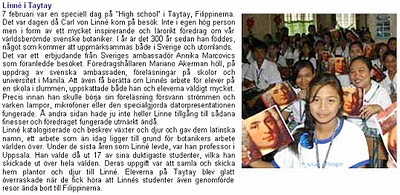
06.03.07 - Maria Presson, "Linné i Taytay," HOPPETS STJÄRNA, Sweden (retrieved 08.02.08) 7 februari var en speciell dag på "High school" i Taytay, Filippinerna. Det var dagen då Carl von Linné kom på besök. Inte i egen hög person men i form av ett mycket inspirerande och lärorikt föredrag om vår världsberömde svenske botaniker. I år är det 300 år sedan han föddes, något som kommer att uppmärksammas både i Sverige och utomlands. Det var ett erbjudande från Sveriges ambassadör Annika Marcovics som föranledde besöket. Föredragshållaren Mariano Akerman höll, på uppdrag av svenska ambassaden, föreläsningar på skolor och universitet i Manila. Att även få berätta om Linnés arbete för elever på en skola i slummen, uppskattade både han och eleverna väldigt mycket. Precis innan han skulle börja sin föreläsning försvann strömmen och varken lampor, mikrofoner eller den specialgjorda datorpresentationen fungerade. Å andra sidan hade ju inte heller Linne tillgång till sådana finesser och föredraget fungerade utmärkt ändå. Linné katalogiserade och beskrev växter och djur och gav dem latinska namn, ett arbete som än idag ligger till grund för botanikers arbete världen över. Under de sista åren som Linné levde, var han professor i Uppsala. Han valde då ut 17 av sina duktigaste studenter, vilka han skickade ut över hela välden. Deras uppgift var att samla och skicka hem plantor och djur till Linné. Eleverna på Taytay blev glatt överraskade när de fick höra att Linnés studenter även genomförde resor ända bort till Filippinerna.
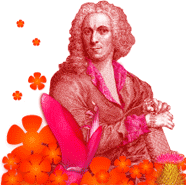 Carolus Linnaeus
Carolus Linnaeus Online resources
• Linnaeus-Manila Program
• In the Spirit of Linnaeus
• What a century!
• Linneo
• Rara avis
• Kingdom and Ecology
• The Same Order
• El mismo orden
• Education
 linnaeus.se
linnaeus.se
